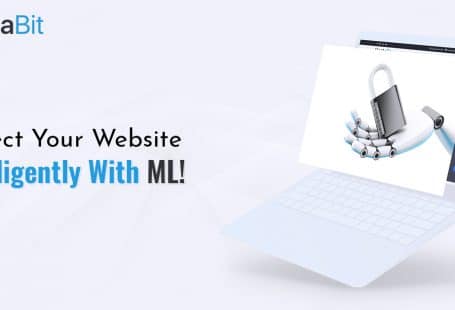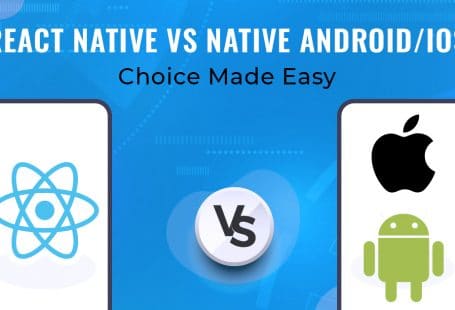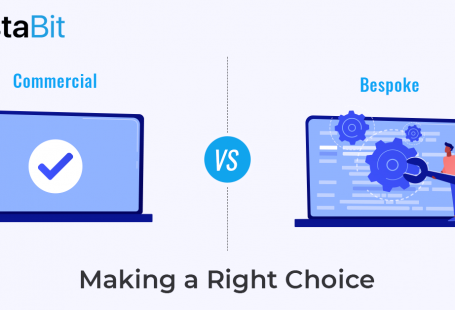I believe you have a fantastic application idea for your next project. But you are compassed with following questions:
- Would any trending technology fit my app idea?
- Will I need a big budget for cross-platform development?
- Could there be any cost-effective solution for my app?
Too many questions and one solution: Flutter app development. You will believe me once you get along with this article.
I remember how we only had native technologies to develop a reliable app in the early days of mobile applications. However, from the past decade, many cross-platform frameworks and systems have popped up. It started with Ionic and Xamarin, then the tools took some time to evolve, came back with Flutter and React Native, and now, they are all over the internet.
If you look at recent times, there is no better alternative for cross-platform app development than Flutter. Enterprises from every corner of the world seek a good flutter app development company to transform their app ideas into reality. What is so different about this technology?
Consider this article as a Flutter guide to your cross-platform application. We are going to talk about every relevant aspect of Flutter app development. Below is a map of the content you signed up for:
- What is Flutter?
- What distincts Flutter from other frameworks?
- How does Flutter work?
- When do companies choose Flutter app development?
- Business and technical pros and cons of Flutter app development.
- Applications made with Flutter.
- FAQs on Flutter.
Let’s get started…
What is Flutter?
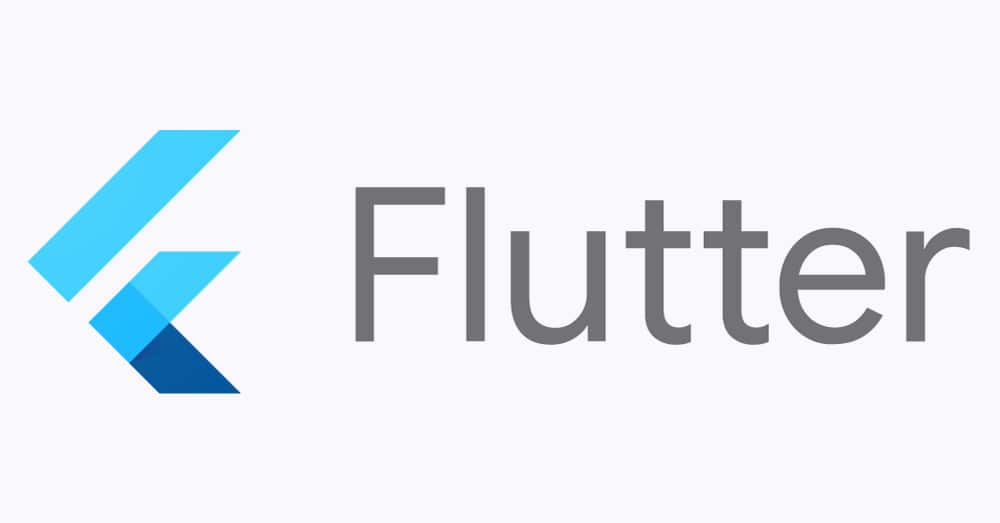
Flutter is an open-source, cross-platform UI toolkit/framework specialising in creating apps for desktop, windows, web and mobile operating systems in a single codebase.
In simple terms, you have to write code once and then use it for all the platforms- Android, iOS, Windows, Mac, Linux, Google Fuschia and the web. The best part about Flutter? Its modern architecture lets you build a functional app with cost and time efficiency.
Flutter’s History in 3 key points:
- Google created Flutter and has been happily vouching for it since 2017. The first version of Flutter was released in Feb 2018, which was a hit.
- Further on May 6 2020, Google released a more stable version of Flutter (version 1.17.0) with network tracking, improved performance and metal APIs.
- As of March 3 2021, Flutter 2 released with official support for web-based applications, along with new CanvasKit and widgets.
Flutter is currently one of the most popular frameworks with 90.4k stars and 18,445 commits on GitHub. If you take a closer look online, you will notice how professionals and all-sized tech companies love Flutter and contribute to making it better.
What distincts Flutter from other frameworks?
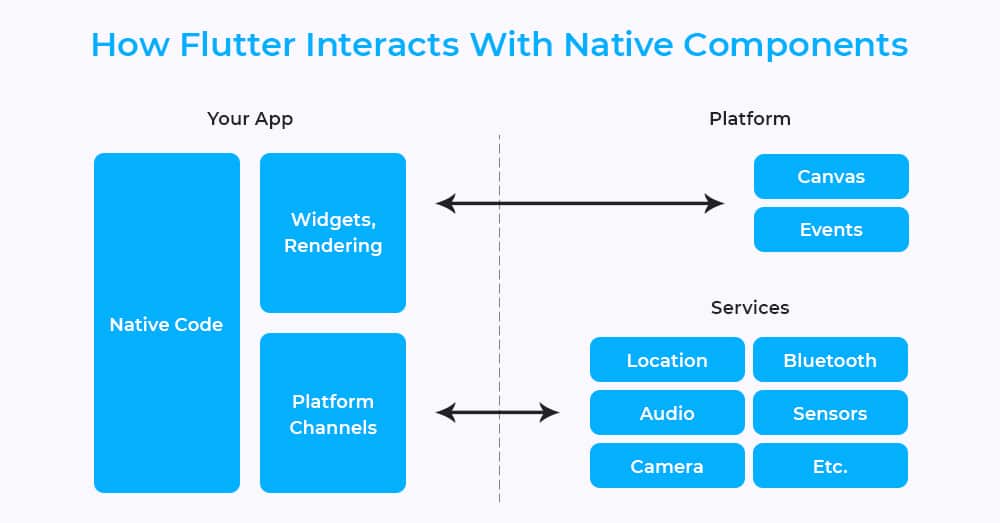
Flutter is a hit because it combines the quality of native with the flexibility of cross-platform development. Contrary to other frameworks, it makes its UI from scratch and does not cover native UI components.
How does Flutter work?
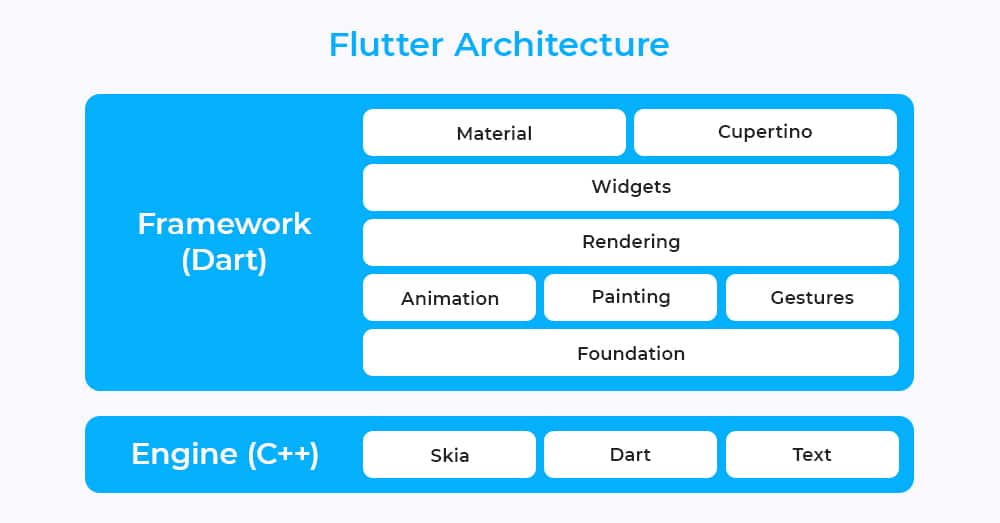
Flutter isn’t merely a framework; it’s an entire SDK toolkit for building functional applications. This indicates that Flutter has everything one needs to design a user interface, including icons and widgets. As a result, you can easily render the interface on iOS and Android.
Okay, we conferred about the UI, but what about the programming language?
Apps that are built using Flutter run on Dart. Dart is an open-source, object-oriented programming language created by Google. Apps use Dart for both client-side and server-side in application development.
Alongside the Dart, Flutter’s core is dedicated to high-speed C++. So now you know, with the power of Dart and C++, the resulting app generates such high animations (60-120fps) that it feels like a native app.
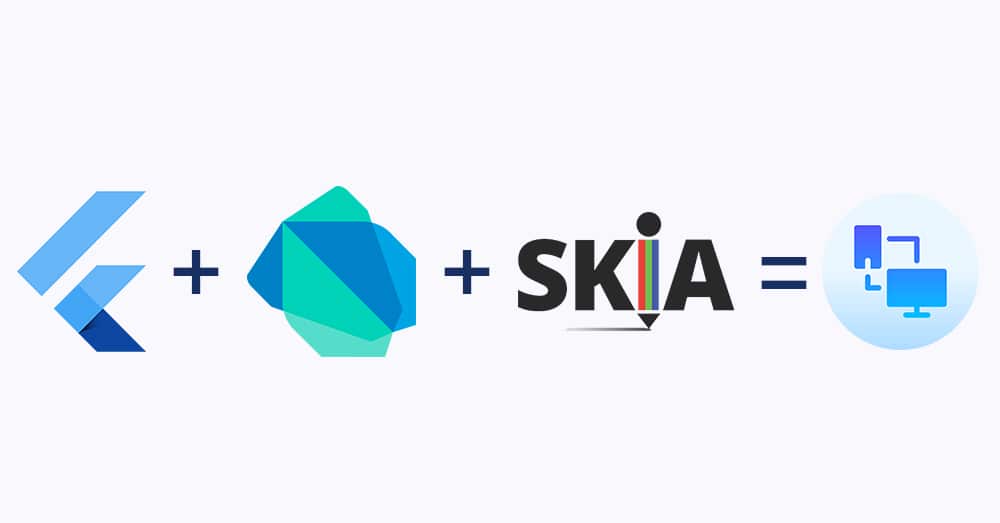
If we talk about how distinct Flutter is with other frameworks like React Native, then Unlike React, Flutter uses all the protocols and channels of the Skia C++ graphics engine.
With Skia onboard, Flutter’s interaction with the operating system’s components is minimal. This reduces the contact bridge and does not impact the app’s performance.
Another critical point in Flutter’s working model is the making of the interface. Similar to game engines with dynamic UI like Unreal, Flutter draws its interface from scratch. Everything from button, media, text to background and elements is drawn inside the Skia graphic engine.
When do companies choose Flutter app development?
Below are the circumstances when companies want their apps built on Flutter:
- When they wish two applications for the price of one.
- When they are short on time and budget.
- When they want a consistent UI on iOS and Android.
- When they know those old native apps can be expensive and hard to maintain.
- When they already have experience with Xamarin/Ionic/Cordova and are looking for better options.
Why should you choose Flutter for Cross Platform Application development?
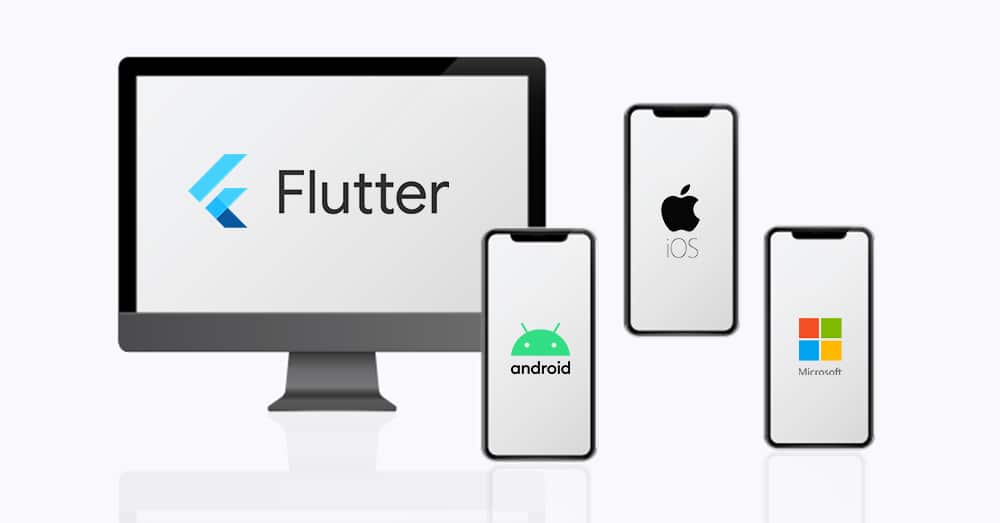
In this section, we will discover some benefits of Flutter covering both business and technical aspects:
Applications developed using Flutter cater to both business owners and tech experts. Business owners acquire an excellent quality application at a reasonable cost, and tech experts gain superb usability and speed.
Let’s get into details:
- Flutter applications are budget-friendly:
This has already been mentioned so many times because the primary objective of every business is to save money without compromising the quality. Flutter can do both. It does not take much time to build apps and would probably not exceed your budget requirements.
Another underrated benefit is the team requirement. You don’t need a big team of developers to work on different OS. Instead, you can hire a small group of professionals from a reliable Flutter apps development agency. Develop the same features with almost half the resources.
- Native-like performance:
When it comes to performance, Flutter= real-time native app.
Flutter, in its recent, 1.17 update makes a bet on the performance factor. The updated version has-
- Memory reduction by 70%.
- Fast scrolling through animated and high-quality large images.
- Minimal usage of CPU and GPU by 40% in terms of simple iOS animations.
- Speed increased up to 25-35% for default navigation.
Besides, Flutter applications do not just work faster; they look great too.
- Faster development:
You probably have heard enterprises building two separate applications using different languages: Kotlin/Java for Android and Obj-C/Swift for iOS.
You can do better with Flutter app development. It uses a single codebase, reduces risks, unifies the team and speeds the development time to market your app faster. All of this under native-like looks and performance sounds like a golden deal.
- Hot Reload feature:
Flutter carries a killer feature called “Hot Reload” that displays all code changes on simulators, emulators and gadgets. If the developers perform any code changes using Flutter, they don’t need to navigate back or recreate any state to analyze differences. All they need to do is click on the Reload button.
On top of that, it becomes easy to keep adding new features to the app without any interference.
- MVP:
When an amazing app idea hits you, you are constantly pressured to exhibit your product to the investor in the shortest time span. Since Flutter lets you build native apps for both iOS and Android, your investors easily grasp the idea behind the final MVP product.
- Widgets:
How your application appears to the user is equally important as how it works. The updated version of Flutter offers interactive designs to create customized widgets. You can use these widgets for the application itself or your entire screen.
- Strong Backend:
Did I already mention that Flutter naturally works very efficiently with firebase that is known to offer the best ecosystems for mobile application development?
Firebase is backed up by Google and provides you with services like hosting, real-time databases, cloud functioning etc.
Therefore, if you are a startup, you can save a lot of resources and time on back end development with Flutter.
Limitations of Flutter App Development
Flutter is not perfect (yet). It is evolving rapidly but giving seamless native-like features and covering every little detail is not a matter of one day.
Here are few things that you should know about before you start working with Flutter:
- Relatively smaller experience-
One of the significant drawbacks of Flutter is its small proven experience. Let’s get practical, it’s a new technology, and no business would want to adopt a new framework only to migrate to native after some time.
But this doesn’t mean that Flutter is unreliable. Google uses Flutter for Google Assistant, Stadia apps and Google Ads. Alibaba created Xianyu using Flutter and Reflectly (built with Flutter) surpassed 1M downloads recently.
This shows that Flutter is popular among tech giants; we just need to give it some time.
- Limited third-party apps-
Again, Flutter is comparatively new and requires more time to come up with third party integrations. The list of tools is constantly growing; meanwhile, new libraries are releasing all the time.
- Dart’s unpopularity:
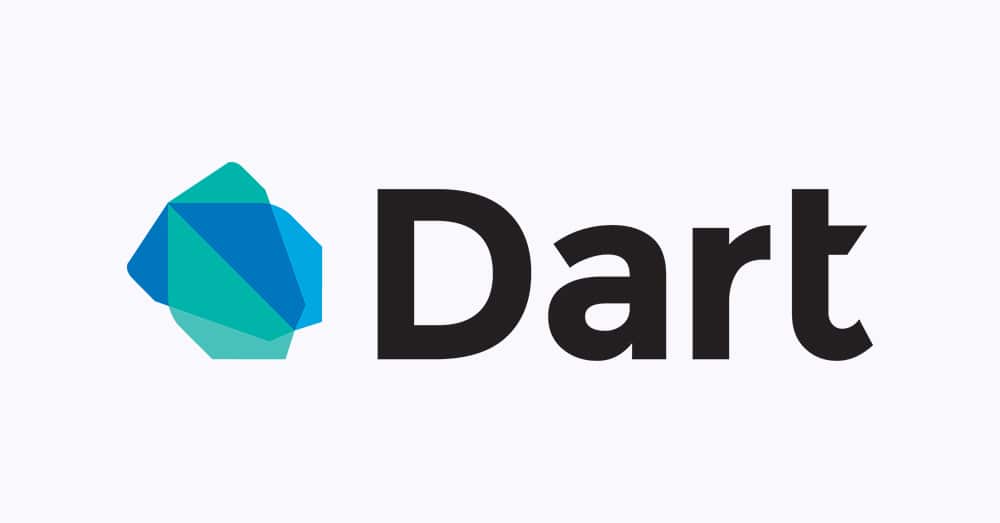
We cannot impose the entire blame on Flutter when Dart is slightly unpopular as a programming language in the industry. In the latest Flutter version, Google brings Dart-2.8, which makes application development even more effortless.
However, it’s difficult for Dart to compete with tech giants like Kotlin, Java and Objective-C. Not many programmers and enterprises pick Dart, which is why the challenges of using Dart development are unanswered.
But don’t you worry because, According to the Octoverse report, Dart has gained 600% contributors on GitHub since 2020.
Applications built using Flutter
In the image below, you can see how many brands happily vouch for Flutter.
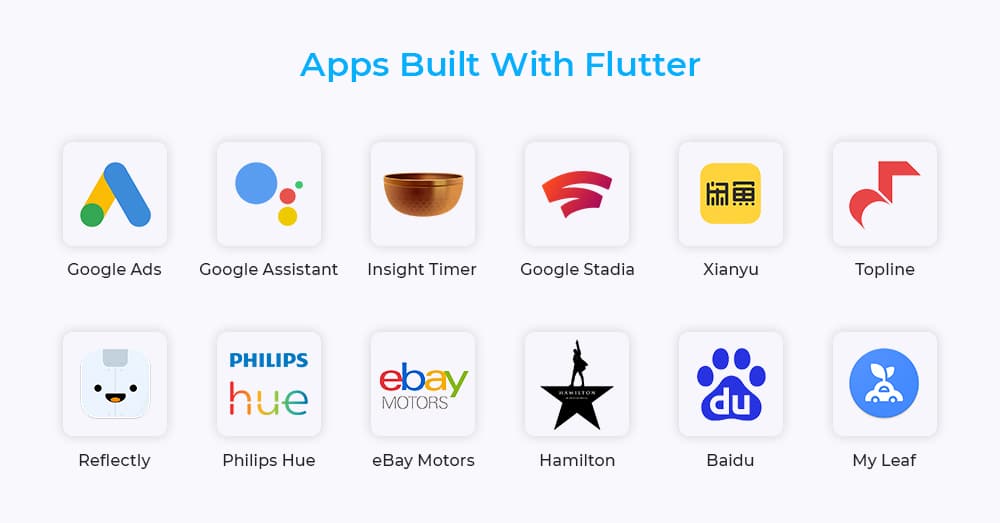
Conclusion
Flutter is a promising technology that is easy to understand and gives you high performing applications. The framework comes with customizable widgets and is likely to fulfil all the requirements for cross-platform app development. Hence, if your next application idea is ready, do not wait to check out the wonders of Flutter.



